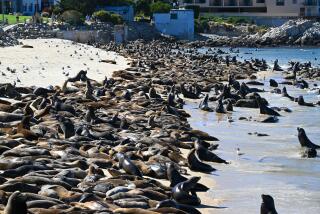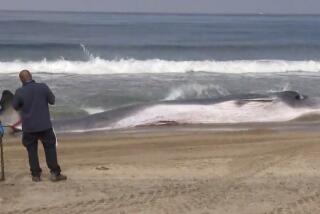SeaWorld San Diego braces for another year of record-breaking sea lion strandings
SeaWorld San Diego officials said this week that they are bracing for another year of record-breaking sea lion strandings, yet one more effect of El Niño.
The fish that sea lions feed on are being driven offshore by unseasonably warm coastal waters, making it harder for the marine mammals to survive. That has resulted in thousands of malnourished sea lions washing ashore on Southern California beaches.
The onslaught is tied to a chain reaction that began in late 2013, when a pool of warm water began forming off the West Coast. The blob persisted, and it may have been intensified by the El Niño climate system that developed in the equatorial Pacific this year.
“The warm water has clearly caused a big change in the marine food web,” said Nate Mantua, a Santa Cruz-based fisheries scientist for the National Oceanic and Atmospheric Administration. “The sardines, anchovies and squid that sea lions depend on have been moving farther from shore, so food is much less abundant.”
That shift has placed a big strain on SeaWorld, which has operated a marine mammal rescue program for decades. The marine park has rescued an unprecedented 973 sea lions this year. The previous record was 474, set in 1983 when the ocean was also warmed by El Niño.
The park has notified its sister facilities in Florida and Texas that it may again need their help in caring for the animals.
SeaWorld San Diego brought in specialists from its parks in Orlando and San Antonio this year to help rehabilitate animals. It also temporarily closed its sea lion and otter shows so staff members in those areas could be shifted to caring for the sick mammals.
The park is preparing to do it again.
“We’ve already contacted our sister parks, letting them know we might need their help with staffing,” said Jody Westberg, coordinator of SeaWorld’s stranded animal program. “We’ve also kept the two supplementary pools that we set up for rehabilitation.... If any stranded animal needs our help, we’ll be there.”
The next wave of strandings is most likely to occur between now and March or April, and rescuers are expecting to find many malnourished animals.
NOAA’s annual autumn survey of a rookery on Southern California’s San Miguel Island revealed that the average weight of 3-month-old female northern fur seal pups was 14.5 pounds, roughly 33% below normal. The weight of female sea lion pups was about 26 pounds, 31% below normal.
“The warm water is likely to stick around for another five or six months due to the influence of El Niño,” Mantua said. “It will peak, then go away. But there’s a hangover effect on the marine food web.”
gary.robbins@sduniontribune.com
Robbins writes for the San Diego Union-Tribune.
More to Read
Sign up for Essential California
The most important California stories and recommendations in your inbox every morning.
You may occasionally receive promotional content from the Los Angeles Times.










